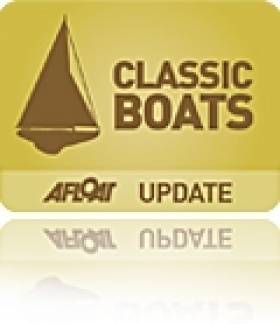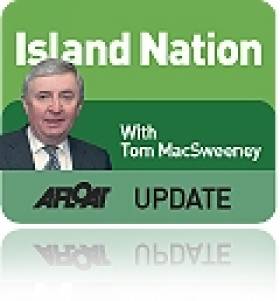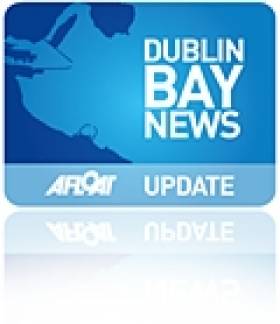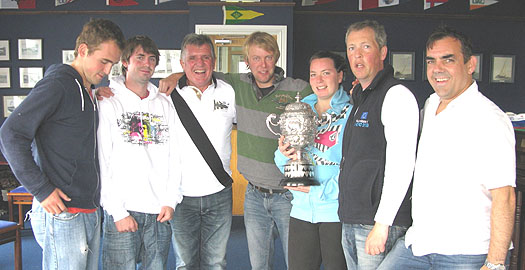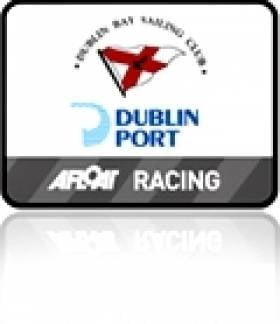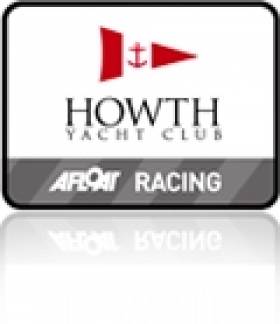Displaying items by tag: Yacht Club
Asgard: The Story of The Most Famous Yacht in Irish History Told This Wednesday At Howth Yacht Club
#hyc – Howth Yacht Club's Pat Murphy presents the life of Asgard, this famous yacht in Irish history from her launch in 1905 to her current conservation in Collins Barracks Museum and the 100th commemoration in 2014. The venue for the special talk is Howth Yacht Club this Wednesday, 18th February at 20:00. The lecture is open to all inlcuding non–yacht club members.
'Asgard's' 23 day voyage to collect the guns and ammunition for the Irish Volunteers and their landing in Howth in July 1914 is described in detail with unique photographs. Also covered will be the landing of Conor O'Brien's 'Kelpie' in Kilcoole.
Donations, no matter how small, will be welcomed on the night for the Howth 17s Heritage Fund.
Who Is To Blame For The Decline in Sailing?
#sailing – Sailing is a sport, not the qualification of a superior social standing.
Is that fully understood by everyone involved in the sport or is there still an element of elitism which needs to be eradicated?
The term 'yachting' was dropped a few years from the title of the national representative organisation which became the Irish Sailing Association, amidst an apparent belief that 'sailing' would be less elitist as a descriptive term and more acceptable to the public.
Most 'yacht' clubs did not become 'sailing' clubs, though there are more 'sailing clubs' it would seem than 'yacht' clubs around the country. Boats did not generally become described in the American term of 'sailboats' but remained yachts.
I see no major problem with the term 'yachting' though I understand the sensitivities which surround the different terminology. I have no qualms about admitting that I own a yacht and feel fortunate to do so.
What is of more concern to me is that the sport becomes truly a 'sport for all' and is not riddled with different levels of social strata.
There remains a degree of public perception that sailing is an elitist sport. This has dogged it gaining more general acceptance and bedevilled its reputation.
Sailing, or yachting, should be a 'sport for all' in an island nation where it is based on access to the magnificent resource of waters surrounding us.
The perception of wealthy people with big boats, sitting in clubs behind signs of 'strictly private', is not conducive to creating a widely popular sport. There is a dichotomy here because the growth of interest amongst young sailors, with more involvement in dinghy sailing such as through Optimists, has been encouraging. So has the advent of more interest in schools in adopting sailing onto their sports curricula.
The movement for change within the ISA came initially from the dinghy fraternity, where many of us who now sail cruisers, began their love affair with the sport.
The breakthrough which sailing needs, to gain more general popular public acceptance, has not been made.
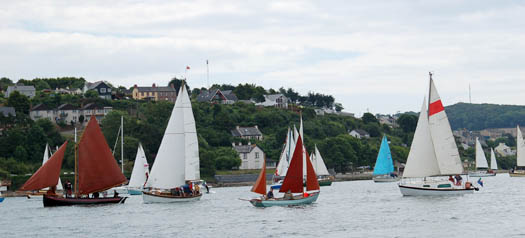
People sail boats of all types
Why is this?
Throughout my years of being a marine journalist and when marine correspondent within RTE, it was difficult to get coverage for sailing. I did achieve it, but there was always a bit of a battle to establish acceptance that the sport was not just for the wealthier part of the population, but that it permeated across all social milieu. I did get that message across by quoting figures of how many are actively involved in a day's racing organised by major clubs, compared with the attendance for example at some Irish soccer matches which got plenty of media coverage. I also stressed that it was a participative sport more than a spectator one. More people within the broadcast service have become involved in the sport. But generally in the media, there is still an impression that sailing is a sport for which you need a lot of money and this is perpetuated by the oft-quoted unfortunate analogy of standing under a cold shower and tearing up money.
But sailing – and yacht – clubs are also contributors to this failure to get the message of sailing as a sport for all across. In my experience as a journalist, most clubs are poor at their public relations and the issuing of information to the press, but yet complain that the sport does not get enough coverage, even if they do not provide the information. There are honourable exceptions, who provide good circulation of information and websites, but there are many other clubs who are pretty bad at sending information and whose websites are dismal failures, not updated for long periods of time.
At the annual meeting of the South Coast Offshore Racing Association in Kinsale Yacht Club in the Spring one participant told the audience that "yacht clubs to most people would be the scariest places to walk into."
Another said: "It is no wonder that we struggle as a sport to keep people as lifelong participants, even though we can and do attract younger people into the sport at an early age."
The warning signs have been there for years, for those who wanted to note them. Sailing needed to widen its appeal, to get more people into the sport for lifelong participation.
To survive a sport needs an organised structure and clubs are needed to provide this, they must have members who pay to join and support them. They cannot exist if people use them without joining and therefore not giving on-going financial and volunteer support.
So there is a dichotomy here. Why are clubs not getting enough members, a situation which appears widespread?
The economy over the past few years has undoubtedly been a contributory factor. People have lacked disposable income and, amongst families in particular, expenditure on non-essential matters has had to be cutback. Some clubs have responded with different arrangements for membership, but as I wrote in this blog last week, I still think that new, flexible approaches are needed, particularly to encourage crews, of which most active racing boats are short.
There are also people who sail and who do not join clubs, either they don't want to, or can't or there are not clubs close to them or for whatever reason. But they do sail, are they outside of the system and should they be considered. How can they be appealed to because they are involved in the sport. There are the traditional boats and the huge support they get. Some are members of the ISA, some of clubs, but many not so perhaps. There is a huge level of support for sailing in this sphere and many organised events which draw big support. Should the ISA reach out to these sailors, to this area of sailing activity?
This and many other aspects merit consideration to band together all interested in sailing, in all its facets. United in approach there would be a strong force which official authorities could not ignore when improved facilities and recognition are sought or when government and officialdom has to be challenged, such as in the imposition of new regulations.
On this month's edition of my radio programme, THIS ISLAND NATION, (click to play podcast above) I talked to the President of the Irish Sailing Association about his plan for a Strategic Review of the sport to deal with a decline and he accepted my suggestion that the impression of elitism is not good for the sport and has not helped its expansion and development. We also discussed whether there was too much concentration on racing and whether more support should be given to other forms of sailing, encouraging cruising.
David Lovegrove wants to get across the message that sailing is open to everyone. He would be particularly happy, he told me, if he could get that understood and accepted widely in public. We discussed how sailing can be a sport for all ages and for all people, with the uniqueness of enabling families to participate together if they wished. He recalled the time when he first got involved in sailing and the enjoyment and sense of friendship that abounded. Perhaps too, we agreed, there was less concentration then on being winners in racing and in high performance levels.
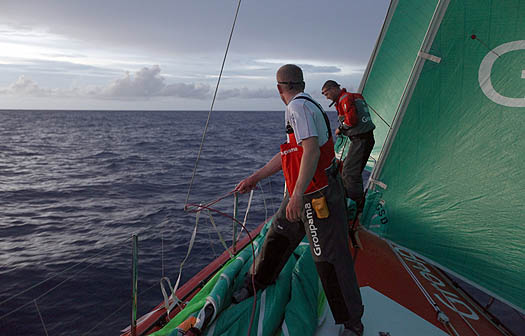
Ocean racer Damian Foxall of County Kerry
I think there is a need for Ireland to have a good presence on the international scene and that it is good for the country. It is also good for sailors to aspire to the highest levels of achievement, but have we got over-committed to competition to the detriment of the enjoyment of participation, of being on the water. Had the ISA also been too focussed on its own high performance programme and those who qualify for it and not given enough support to other sailors who may not have made it through the ISA system, but want to try on the international scene and should there be arrangements to support that. Also, for example, has the ISA been close enough to the top international sailors who have come from Ireland and sought to include them and utilise their services in promoting Irish sailing, such as Damian Foxall and Justin Slattery and where is the ISA in regard to the efforts of such as young David Kenefick making his own way onto the international scene through the Figaro Race.
All of these are interesting points to debate.
I take part in club racing, but I always try to make it clear to the crew that we are going out to enjoy ourselves and winning is not the overall aim, though it would be nice and we have been fortunate enough to do so from time-to-time. I don't like shouting on a boat, though sometimes getting something done quickly when needed can raise the vocal level. But if the enjoyment is taken out of the sport, that is not for the best.
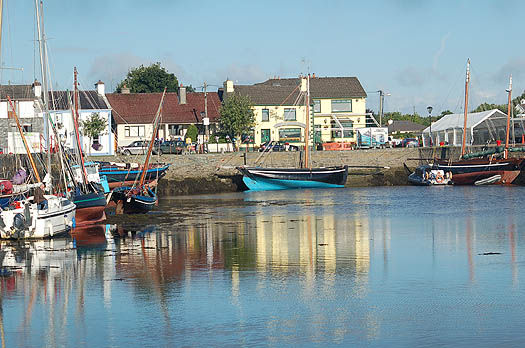
All forms of sailing need to be engaged
Again, here we have a dichotomy, other sports are hugely competitive-oriented, why should sailing not be?
There are issues to be addressed and I wish David Lovegrove and his team every success as they try to come up with answers. He told me in our interview, that this would not be a short-term solution, but would take a lot of work and commitment by the clubs themselves. Indeed. As I wrote in this blog last week, encouraging participation is essential to arrest decline. That will mean more innovative ways of involving people, a point which Denis Kiely, who has given tremendous national service to sailing made at that SCORA meeting in Kinsale and which impressed me.
He said that often crews did not get enough of a proper introduction to the sport, didn't have enough knowledge of it and weren't given such, didn't get training, could therefore feel unwelcome and then leave the sport.
Club marinas are pretty full of boats around the country, so it is at times hard to accept that there is a decline in participation, but the meetings which have led to the new approach by the ISA have shown problems, including dissatisfaction with the national association itself. David Lovegrove has accepted this and the need for change.
He spoke to me of his enthusiasm about the work ahead to re-define the sport and his confidence in the team he has appointed to oversee different aspects of the sport and to suggested changes. These are outlined in detail in the current/Summer edition of AFLOAT magazine.
His determination to create a strong, vibrant sport, is welcome. I wish him success with his efforts. Listen to his interview in my programme here on the Afloat website (above). Everyone interested in the future of our sport should respond positively. That commitment is what the sport needs.
So – who is to blame for the decline in sailing – all of us are, if we do not make changes to encourage more people into the sport and to stay in it and if we do not adapt existing systems to ensure they feel welcome. That means all of us who want to see sailing being a sport for all accepting that sailing is just that - a sport - not a badge of social approval.
#dlmarina – A year after yacht clubs reacted to a cut in Dun Laoghaire Harbour's swinging moorings, the Royal St. George, has vacated it s long held east bight moorings at the request of the Dun Laoghaire harbour Company and relcoated to the town marina.
The harbour company requires the east bight area to facilitate visiting cruise ships, a new area of revenue for the harbour.
The Royal St.George, the country's biggest club, says 'As opposed to doing a partial withdrawal over the 2014/2015 seasons we have agreed a new facility with Dun Laoghaire Marina in their West Bight section'.
It is intended that all Royal St George boats on the East Bight will relocate. Moorings in front of the club house are currently unaffected. The club says it has agreed a very favourable rate with the marina and takes into account the notified increases for mooring charges.
A launch service between the club and the Marina will be available and currently a scheduled service is being drawn up, this will be the only point of access to the West Bight.
The initial agreement between the club and the marina is for a period of 4 years.
The club website advises 'the West Bight berthing rate exclusive to RSGYC members will be €170 p/ meter vs. the Marina's advertised rate of €217.50 p/ meter' This rate is available from Lift In – Lift Out and only to RSGYC members that availed of moorings in the last few years.
For 2013 Royal St.George mooring rates were €147 p/ meter. With the increases from the Harbour Co for 2014 the rate would be in the region of €155 p/ meter, the club estimates.
The west bight marina facility will only be accessible from the RSGYC club house pontoons and will be served by the Launch Service with one pickup/ drop off point on the West Bight which will increase efficiency.
#yachtclubs – The antiquity of Irish recreational sailing is beyond dispute, even if arguments arise as to when it started, and whether or not the Royal Cork YC really is the world's oldest club in its descent from the Water Club of the Harbour of Cork from 1720. But all this seems academic when compared with the impression made by relics of Ireland's ancient sailing traditions.
In just six short years, the Royal Cork Yacht Club will be celebrating its Tercentenary. In Ireland, we could use a lot of worthwhile anniversaries these days, and this 300th has to be one of the best. The club is so firmly and happily embedded in its community, its area, its harbour, in Munster, in Ireland and in the world beyond, that it is simply impossible to imagine sailing life without it.
While the Royal Cork is the oldest, it's quite possible it wasn't the first. That was probably something as prosaic as a sort of berth holder's association among the owners of the ornamental pleasure yachts which flourished during the great days of the Dutch civilisation in the 16th and 17th Centuries. They were based in their own purpose-built little harbours along the myriad waterways in or near the flourishing cities of The Netherlands. Any civilisation which could generate delightful bourgeois vanities like Rembrandt's Night Watch, or extravagant lunacies such as the tulip mania, would have had naval-inspired organised sailing for pleasure and simple showing-off as central elements of its waterborne life.
Just sailing for pleasure and relaxation, rather than going unwillingly and arduously afloat in your line of work, seems to have been enough for most. Thus racing – which is the surest way to get some sort of record kept of pioneering activities – was slow to develop, even if inter-yacht matches were held, particularly once the sport had spread to England with the restoration of Charles II in 1660.
Ireland had not the wealth and style of either Holland or England, but it had lots of water, and it was in the very watery Fermanagh region that our first hints of leisure sailing appeared. It's said of Fermanagh that for six months of the year, the lakes are in Fermanagh, and for the other six, Fermanagh is in the lakes. Whatever, the best way to get around the Erne's complex waterways system, which dominates Fermanagh and neighbouring counties, was by boat. By the 16th Century Hugh Maguire, the chief of the Maguires, aka The Maguire, had a Lough Erne-based fleet, some boats of which were definitely for ceremonial and recreational use.
Sport plays such a central - indeed total - role in Irish life that it's highly likely these pleasure sailing boats were sometimes used for racing. However, the first recorded race anywhere in Ireland took place in Dublin Bay in 1663 when the polymath Sir William Petty, having built his pioneering catamaran Simon & Jude, then organised a race with a Dutch sailing vessel and a local "pleasure boatte" of noted high performance. This event, re-sailed in 1981 when the indefatigable Hal Sisk organised the building of a re-creation of the Simon & Jude, resulted both times in victory for the new catamaran. But because a larger sea-going version of the Simon & Jude, called The Experiment at the suggestion of Charles II himself, was later to founder with all hands while on a testing voyage in the Bay of Biscay, the multi-hull notion was abandoned in Europe for at least another two centuries.
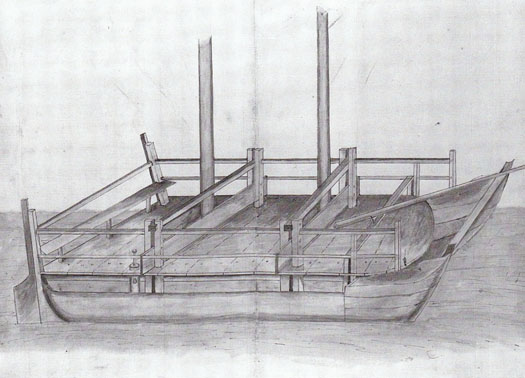
Contemporary drawing of the 17th Century catamaran Simon & Jude, which was built in Dublin and tested in the bay in an early "yacht race" in 1663.
We meanwhile are left wondering just what was this "pleasure boatte" was, and who owned and sailed it. Its existence and good sailing performance seems to have been accepted as unremarkable in Dublin Bay, yet no other record or mention of it has survived.
It was the turbulent life of Munster in the 17th Century which eventually created the conditions in which the first yacht club was finally formed. As the English Civil War spread to Ireland at mid-Century with a mixture of internecine struggle and conquest, the Irish campaigner Murrough O'Brien, the Sixth Baron Inchiquin, changed sides more than once, but made life disagreeable and dangerous for his opponents whatever happened to be the O'Brien side for the day.
Yet when the forces supporting Charles II got back on top in 1660 after the death of Cromwell in 1658, O'Brien was on the winning side. As the dust settled and the blood was washed away, he emerged as the newly-elevated Earl of Inchiquin, his seat at Rostellan Castle on the eastern end of Cork's magnificent natural harbour, and his interests including a taste for yachting acquired with his new VBF Charles II.
But there was much turmoil yet to come with the Williamite wars in Ireland at the end of the 17th Century. Yet somehow as the tide of conflict receded, there seemed to be more pleasure boats about Cork Harbour than anywhere else, and gradually their activities acquired a level of co-ordination. The first Earl of Inchiquin had understandably kept a fairly low profile once he got himself installed in his castle, but his descendants started getting out a bit and savouring the sea. So when the Water Club came into being in 1720, the fourth Earl of Inchiquin was the first Admiral.
In the spirit of the times, having an aristocrat as top man was sound thinking, but this was truly a club with most members described as "commoners", even if there was nothing common about their exceptional wealth and their vast land-holdings in the Cork Harbour area. Much of it was still most easily reached by boat, thus sailing passenger vessels and the new fancy yachts interacted dynamically to improve the performance of both.
Yet there was no racing. Rather, there was highly-organised Admiral Sailing in formation, something which required an advanced level of skill. However, many of the famous club rules still have a resonance today which gives the Water Club a sort of timeless modernity, and bears out the assertion by some historians that, as it all sprang to life so fully formed, the formation date of 1720 must be notional, as all the signs are that there had been a club of some sort for years beforehand.
But either way, it makes no difference to the validity or otherwise of the rival claim, that the Squadron of the Neva at St Petersburg in Russia, instituted by the Czar Peter the Great in 1718 to inculcate an enthusiasm for recreational sailing among Imperial Russia's young aristocrats, was the world's first yacht club. It was no such thing. It was in reality a unit of the Russian navy, and imposed by diktat from the all-powerful ruler. As such, it was entirely lacking the basic elements of a true club, which is a mutual organisation formed by and among equals.
Yet as the Water Club of the Harbour of Cork had no racing with results published in what then passed for the national media, we are reliant on the few existing club records and some travel writing from the time for much of our knowledge of the early days of the Water Club. That, and the Peter Monamy paintings of the Water Club fleet at sea in 1738.
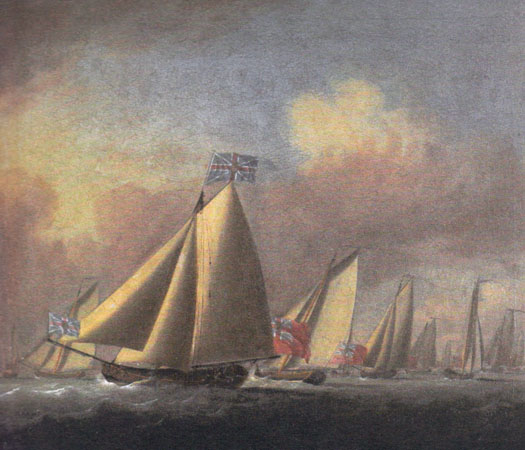
A remarkably well-disciplined fleet. Peter Monamy's 1738 painting of the yachts of the Water Club at sea off Cork Harbour. They weren't racing, but were keeping station in carefully-controlled "Admiral Sailing". Courtesy RCYC
Fortunate indeed are the sailors of Cork, that their predecessors' activities should have been so superbly recorded in these masterpieces of maritime art. The boats may look old-fashioned to a casual observer, yet there's something modern or perhaps timeless in this depiction of the fleet sailing in skilled close formation, and pointing remarkably high for gaff rigged boats as they turn to windward. Only a genuine shared enthusiasm for sailing could have resulted in such fleet precision, and in its turn in a memorable work of art. It is so much part of Irish sailing heritage that we might take it for granted, but it merits detailed study and admiration no matter how many times you've seen it already.
Shortly after Monamy's two paintings were completed, Ireland entered a period of freakish weather between 1739 and 1741 when the sun never shone, yet it seldom if ever rained, and it was exceptionally cold both winter and summer. It is estimated that, proportionately speaking, more people died in this little known famine than in the Great Famine itself 104 years later. While the members of the Water Club would have been personally insulated from the worst of it, the economic recession which struck an intensely agricultural area like Cork affected all levels of society.
Thus the old Water Club saw a reduction in activity, but though it revived by the late 1740s, the sheer energy and personal commitment of its early days was difficult to recapture, and by the 1760s it was becoming a shadow of its former self. Nevertheless there was a revival in 1765 and another artist, Nathanael Grogan, produced a noted painting of Tivoli across from Blackrock in the upper harbour, with a yacht of the Water Club getting under way for a day's recreation afloat, the imminent departure being signalled by the firing of a gun.
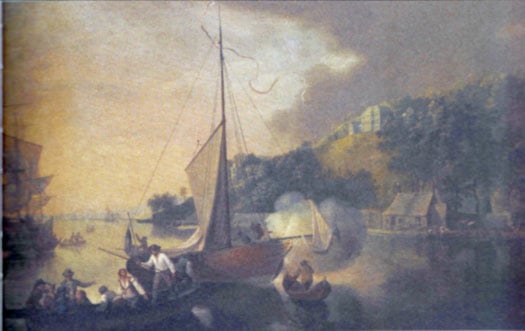
The best way to get the crew on board....on upper Cork Harbour at Tivoli in 1765, a yacht of the reviving Water Club fires a gun to signal imminent departure.
However, it was on Ireland's inland waterways that the next club appeared – Lough Ree Yacht Club came into being in 1770, and is still going strong. That same year, one of the earliest yacht clubs in England appeared at Starcross in Devon, but it was in London that the development pace was being most actively set with racing in the Thames for the Cumberland Fleet. Some members of this group, after the usual arguments and splits which plague any innovative organisation, in due course re-formed themselves as the Royal Thames Yacht Club in the early 1800s. But the famous yet unattributed painting of the Cumberland Fleet racing on the Thames in 1782, while it is slightly reminiscent of Monamy's painting of the Water Club 44 years earlier, undoubtedly shows boats racing. And they'd rules too – note the port tack boat on the right of the picture bearing off to give way to the boat on starboard.
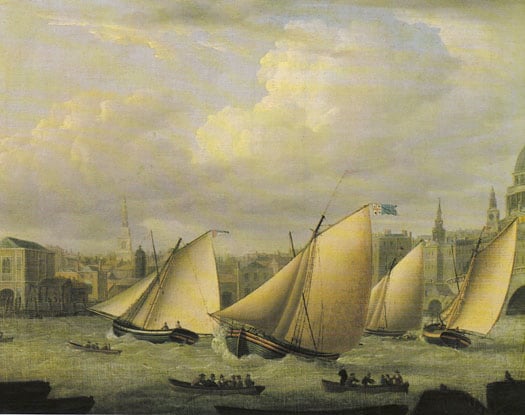
Definitely racing – the Cumberland Fleet, precursor of the Royal Thames Yacht Club, racing in the River Thames at Blackfriars in 1782.
The Thames was wider in those days, but even so they needed strict rules to make racing possible. Dublin Bay offered more immediate access to open water, and there were certainly sailing pleasure boats about. When the Viceroy officially opened the Grand Canal Dock on April 23rd 1796, it was reported that the Viceregal yacht Dorset was accompanied by a fleet of about twenty ceremonial barges and yachts. Tantalisingly, the official painting is almost entirely focused on the Dorset and her tender, while the craft in the background seem to be naval vessels or revenue cutters.
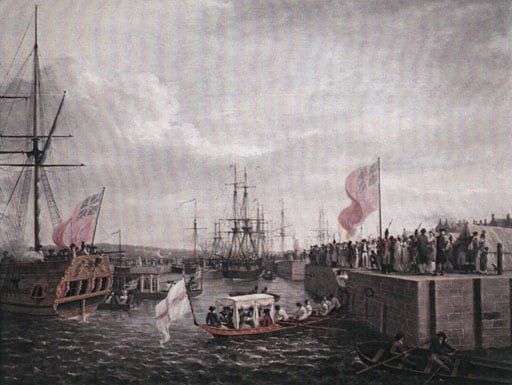
This painting of the opening of the Grand Canal Dock in 1796 tends to concentrate on the ceremonials around the Viceroy's yacht Dorset in the foreground, but fails to show clearly any of the several privately-owned yachts which were reportedly also present....
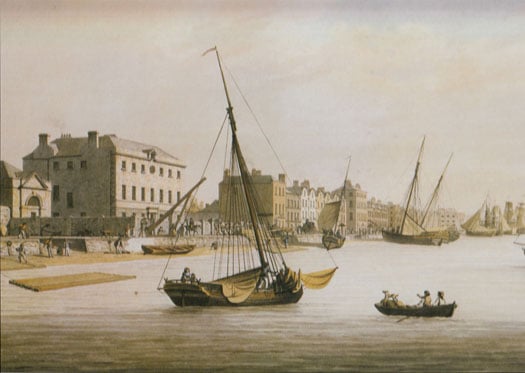
.......but this illustration of the old Marine School on the South Quays in Dublin in 1803 seems to have a yacht – complete with owner and his pet dog on the dinghy in the foreground – anchored at mid-river.
However, a Malton print of the Liffey in 1803 shows clearly what is surely a yacht, the light-hearted atmosphere of waterborne recreation being emphasised by the alert little terrier on the stern of the tender conveying its owner in the foreground Meanwhile in the north of Ireland there was plenty of sailing space in Belfast Lough, while Belfast was a centre of all sorts of innovation and advanced thinking. Henry Joy McCracken, executed for his role in the United Irishmen's rising in 1798, was a keen pioneer yachtsman. As things took a new turn of determined money-making in Belfast after the Act of Union of 1801, some of his former crewmates were among those who formed the Northern Yacht Club in 1824, though it later transferred its activities across the North Channel to the Firth of Clyde, and still exists as the Royal Northern & Clyde YC.
Meanwhile in 1806 the old Water Club of the Harbour of Cork had shown new signs of life, but one result of this was an eventual agreement among members - some of them very old indeed, some representing new blood - that the club would have to be re-structured and possibly even given a new name in order to reflect fresh developments in the sport of yachting. The changeover was a slow business, as it had to honour the club's history while giving the organisation contemporary relevance. Thus it was 1828 before the Royal Cork Yacht Club had emerged in this fully fledged new form, universally acknowledged as the continuation of the Water Club, and incorporating much of its style.
But it was across the north on Lough Erne in 1820 that the world's first yacht club specifically set up to organise racing was formed, and Lough Erne YC continues to prosper today, its alumnae since 1820 including early Olympic sailing medallists and other international champions.
There must have been something in the air in this northwest corner of Ireland in the 1820s, for in 1822 the men who sailed and raced boats on Lough Gill at Sligo had a pleasant surprise. Their womenfolk got together and raised a subscription for a handsome silver trophy to be known as the Ladies' Cup, to be raced for annually – and it still is.
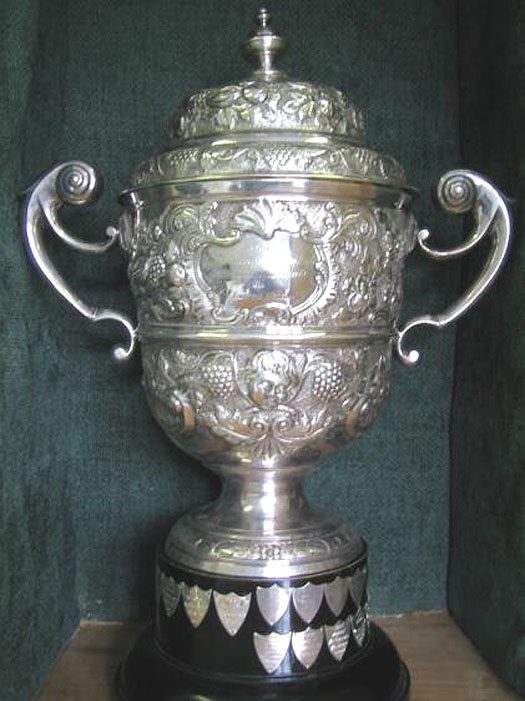
Instituted in 1822, the Ladies' Cup of Sligo YC is the world's oldest continually-contested annual sailing trophy.
Annual challenge cups now seem such a natural and central part of the sailing programme everywhere that it seems extraordinary that a group of enthusiastic wives, sisters, mothers and girlfriend in northwest Ireland were the first to think of it, yet such is the case. Or at least theirs is the one that has survived for 192 years, so its Bicentenary in 2022 is going to be something very special.
Those racing pioneers of the Cumberland Fleet had made do with new trophies freshly presented each year. And apparently the same was the case initially at Lough Erne. But not so very far down the road, at Sligo, somebody had this bright idea which today means that the museum in Sligo houses the world's oldest continually raced-for sailing trophy, and once a year it is taken down the road to the Sligo YC clubhouse at Rosses Point to be awarded to the latest winner – in 2013, it was the ever-enthusiastic Martin Reilly with his Half Tonner Harmony.
The Ladies Cup was won in 2013 by Martin Reilly's Half Tonner Harmony. Pictured with their extremely historic trophy are (left to right) Callum McLoughlin, Mark Armstrong, Martin Reilly, John Chambers, Elaine Farrell, Brian Raftery and Gilbert Henry
However, although the Ladies' Cup may have pioneered a worthwhile trend in yacht racing, it wasn't until 1831 that they thought of inscribing the name of the winner, and that honour goes to Owen Wynne of Hazelwood on the shores of Lough Gill. But by that time the notion of inscribing the winners was general for all trophies, and a noted piece of the collection in the Royal Cork is the Cork Harbour Regatta Cup 1829, and on it is inscribed the once-only winner, Caulfield Beamish's cutter Little Paddy.
The name of noted owner, skipper and amateur yacht designer Caulfield Beamish came up here some time back, when we were discussing how in 1831 he took a larger new yacht to his own design, the Paddy from Cork, to Belfast Lough where he won a stormy regatta. So you begin to understand the mysterious enthusiasm people have for sacred relics when you see this cup with its inscription, and realise that it's beyond all doubt that this now-forgotten yet brilliant pioneer of Cork Harbour sailing development personally held this piece of silverware.
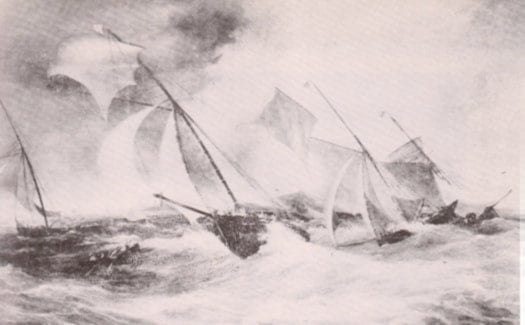
Caulfield Beamish's new cutter Paddy from Cork (which he designed himself) winning a stormy regatta in Belfast Lough in 1831
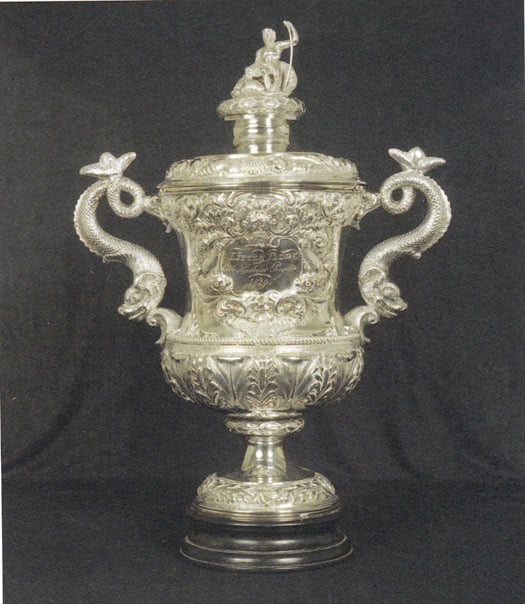
The Cork Harbour Regatta Cup of 1829.....Courtesy RCYC
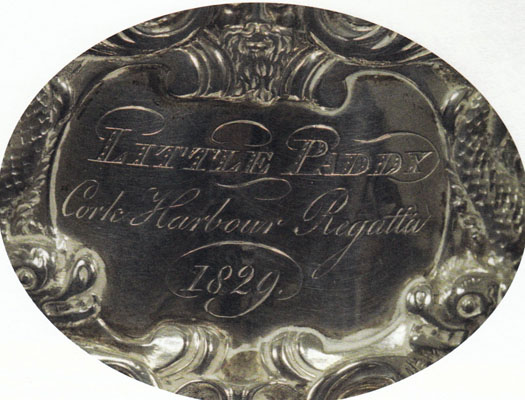
....and on it is inscribed the winner, Caulfield Beamish's earlier boat, Little Paddy, which he also designed himself. Courtesy RCYC
Another pioneer in yacht racing at the time was the Knight of Glin from the Shannon Estuary, who in 1834 was winning all about him with his cutter Rienvelle, his season's haul including a silver plate from a regatta in Galway Bay – it's now in Glin Castle – while he also seems to have relieved fellow Limerick owner William Piercy of £50 for a match race in Cork Harbour against the latter's cutter Paul Pry.
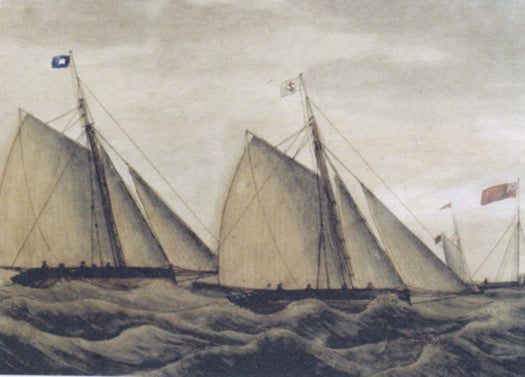
The lads from Limerick hit Cork. William Piercy's Paul Pry racing for a wager of £50 against the Knight of Glin's Rienvelle in Cork Harbour in 1834. When Paul Pry won Cork Harbour Regatta a few weeks later, the band on the Cobh waterfront played Garryowen. Courtesy RCYC
But of all the fabulous trophies in the Royal Cork collection, the one which surely engenders the most affection is the Kinsale Kettle. It goes back "only" to 1859, when it was originally the trophy put up for Kinsale Harbour Regatta. But this extraordinarily ornate piece of silverware was not only the trophy for an annual race, it was also the record of each race, as it's inscribed with brief accounts of the outcomes of those distant contests.
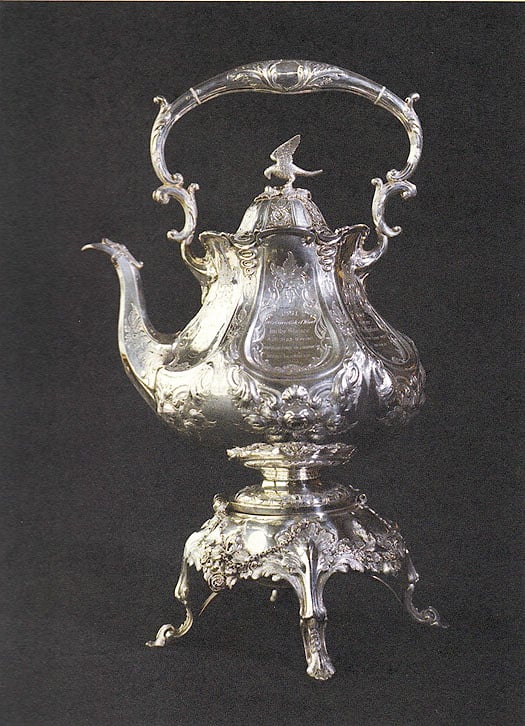
An extraordinary piece of Victorian silverware. The "Kinsale Kettle" from 1859 is now the Royal Cork YC's premier trophy.
Today, it continues to thrive as the Royal Cork Cup, the premier award for Cork Week. The most recent winner in 2012 was Piet Vroon with his superb and always enthusiastic Tonnere de Breskens. The fact that this splendid ambassador for Dutch sailing should be playing such a central role in current events afloat here in Ireland brings the story of our sport's artworks and historical artefacts to a very satisfactory and complete circle.
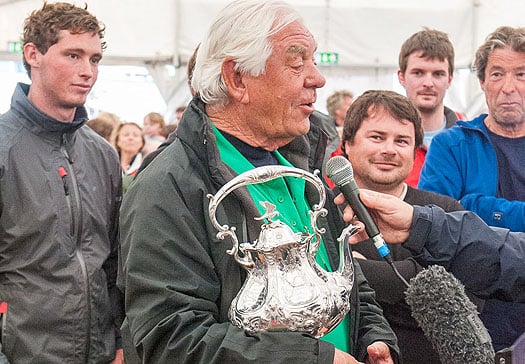
More tea, skipper? The current holder of the Kinsale Kettle, aka the Royal Cork Cup, is Piet Vroon of Tonnere de Breskens. Photo: Bob Bateman
#yachtclubs – A new Dun Laoghaire-based political party, People United in Republican Endeavour (PURE), has launched its campaign for the forthcoming Local Government Elections with demands for changes in the style and names of the leading yacht clubs, both in Dun Laoghaire and throughout Ireland reports W M Nixon.
Introducing a Policy Document on behalf of PURE, the new party's spokesman Mr Hugh Mannity stated: "It makes me suffer to see these unfortunate people, the members of the Dun Laoghaire waterfront yacht clubs, being forced into aping the airs and graces of their former colonial oppressors".
"Despite the imminence of a State Visit to the Queen of England by the President of Ireland, we who are PURE demand that all vestiges of former royal dominance and patronage be removed entirely from every organisation, building and boat in Ireland".
However, Mr Mannity insisted that the changeover would be effected with a minimum of expense. "We know that perhaps the most costly aspect of this fresh new initiative will be in the changing of signs, letterheads and so forth," he said. "In the case of yachts, there would be additional expense in changing the lettering on the hulls denoting the club to which the owner belongs."
The Research Department in PURE has been burning the midnight oil, Mr Mannity claimed, in order to minimise expense, or indeed make it unnecessary altogether. "Thanks to our far-seeing think tank," he said, "the initials for the Royal Irish Yacht Club will stay exactly the same, only now it will be known as the Republic of Ireland Yacht Club".
"Equally, the Royal St George Yacht Club will retain its initials, but the title of the club will be changed to the Religious St George Yacht Club. This is because we in PURE find it doubly offensive that a leading yacht club should have a royal title combined with a political overtone which completely ignores the underlying theme of the sanctity of St George. So we hope to put the holiness back into the club for the good of its members"
"A problem arises with the Royal Alfred Yacht Club. We find it offensive that it should commemorate a now unknown son of the ruthless Queen Empress Victoria. Thus we have decided that, while it should retain its present initials, it should henceforth be known as the Real Alfie Yacht Club, named in honour of the much-loved long-term Lord Mayor of Dublin Alfie Byrne, who was also world-renowned for his pioneering work in moustache research and manipulation."
Mr Mannity continued by stating that his grouping would show its even-handedness by insisting on a change in the title of the National Yacht Club. "While we laud this fine club's lack of any royal associations in its name," he said, "we are concerned that these days too many organisations, in sailing as elsewhere, insist on having "National" in their title, thereby rendering it meaningless. Thus we will expect the NYC to become the TNYC – the True National Yacht Club. We appreciate that this will cause the members some expense, but our Field Researchers who regularly walk Dun Laoghaire's East Pier with their whippets tell us that, judging by the boats stored in the club's forecourt, the members could well afford to lay out the money on a 'T'."
When questioned about PURE's intentions regarding the Royal Cork Yacht Club, Mr Mannity said he did foresee a special problem. The Republic of Cork already existed within the Rebel County, and re-naming the club would be a matter of whether or not it became the Republic of Cork Yacht Club, or the Rebel County Yacht Club. "There could well be blood in the streets over that one" he admitted.
However, in order to show the depth of research undertaken by PURE's think tank on this entire matter, Mr Mannity pointed outthat not many people were aware that within the Royal Cork YC's present structure, the old Royal Munster Yacht Club still existed, and was recognised by the role of Commodore in the RCYC officer board, along with the Admiral.
"We feel that too many problems would be created by trying to establish a Republic of Munster in order to facilitate the existence of a Republic of Munster Yacht Club. Thus we have decided it should be re-titled the Province of Munster Yacht Club. We realise that this will necessitate a small change in the initial letter. But where some traditionalists still have RMYC across the sterns of their boat, we would point out that changing it to PMYC would only involve painting out one little leg of the letter 'R'. However, to show our goodwill, a small phial of white paint will be provided to owners to facilitate the change. We realise that this will only work with white boats. But the Irish taxpayer cannot be expected to fork out hard-earned cash for the awkward minority who insist on parading about on the ocean in boats coloured Mediterranean Blue or Sunset Red or whatever, when any civilised person knows that all proper yachts are white".
In concluding his PURE statement, Mr Mannity admitted that the root of the problem in creating a Republic of Munster lay in the continuing existence of the Kingdom of Kerry. "We're not crazy" he asserted. "We know that trying to subsume Kerry into a new Republic in a combination with Cork would be a step too far".
"Nevertheless we feel strongly that it is time and more for the good people of Kerry to reconsider their claims to the status of being a monarchy. Thus we propose what we feel will be a real vote getter. We plan to re-position Kerry as a Duchy. And plans are well advanced to request a noted KiIgarvan family to become the hereditary Dukes of Kerry. We feel sure that this brilliant innovative idea will be a surefire runner"
New 'Ensign' Class Takes off for Dublin Bay Sailing Club
Tomorrow is the penultimate race of the DBSC season, a season in which the 350-boat club tackled the long standing problem of crew shortages. Together with Dun Laoghaire's waterfront yacht clubs, DBSC introduced an 'Ensign Class' to extend the possibility of bay racing to a greater of people.
Up to 1,500 sailors race each Thursday and Saturday during the Summer but typically cruiser classes, which represent the bulk of the fleet, always run short of crew. A typical 30 foot boat can require a crew pool of 15 or more.
People with no experience are now being taken afloat in a cosseted fashion by the club and introduced to the rudiments of sailing.
The idea has proved so successful the National Yacht Club now operates a waiting list for its club 1720 sports boats, the Ensign class of choice.
The hope is that racing skippers, who rarely want complete novices onboard but who are nevertheless short of crew, will be encouraged to pick from those graduating from the Ensigns.
DBSC's Hon-Sec Donal O'Sullivan says the pilot project looks set to continue into the winter for the popular Turkey Shoot Series.
Trinculo Triumphs in IRC One
Chart House on the Property Map in Kinsale
An appropriately named house for a sailing setting is on the market in Kinsale, County Cork. The Chart House is a 7-bed period house currently operating as a luxurious Bed and Breakfast.
The property is situated in the heart of Kinsale and within walking distance of Kinsale Yacht Club. It's on the market for €650,000. More here.
Click this link for the latest in Irish waterfront property
Rejig Means No South Coast Match Racing Fixtures
There will be no match racing on the south coast this year following a rejig of the fixtures calendar.
After two years of expansion for match racing in terms of events the theme for 2011 is consolidation.
Changes to the ISA SailFleet schedule for the boats mean that we have had to go through a rejigging of the match racing calendar.
The major impact is that Royal Cork YC are to take the boats latter than originally hoped meaning that they will be unable to host a leg of the Tour.
With Kinsale not taking part in the SailFleet scheme this year that means no match racing on the south coast for the first time in a couple of years.
With no tie up with the Dun Laoghaire Festival of Cultures available this year a date of July 23rd and 24th has been settled on for the Ireland vs The World International.
The highlight of last year this event will once again pit Irelands 6 best match racers against 6 teams from the rest of the world. Once again National and Tour champion John Sheehy will captain the Irish team.
The Leinster Match Racing Open, to be hosted by the Royal Irish Yacht Club, has been moved to July 16th and 17th to allow it to act as qualification for the Irish team for the following weekend and to give Laura Dillion and the Gladiators (Sam Hunt, Paddy Blackley, Peter Bayly, Richard Murphy) competitive practice immediately before heading over to Poland to represent the country at the ISAF Nations Cup.
Howth Yacht Club's, Dublin Match Racing Open stays with a date of September 3rd and 4th before we head for Lough Derg and the Womens (October 15th and 16th) and Open National Championships (November 5th And 6th).
All of the above means that here will be no Munster Match Racing Open this year and work continues to find a host for the IUSA Student Match Racing Nationals with Galway a potential for early April. There has been considerable work on the cost of entry for events over the winter and the majority of events will have a basic entry of €330 this year. All events will be run at ISAF grade 3.
Revised calendar
July 16-17th – Leinster Match Racing Open, Royal Irish Yacht Club
July 23-24th – Ireland vs The World International, Royal St George Yacht Club
September 3rd and 4th – Dublin Match Racing Open, Howth Yacht Club
October 15th and 16th - Womens Match Racing Championships, Lough Derg Yacht Club
November 5th and 6th – National Match Racing Championships, Lough Derg Yacht Club
Royal Cork Seek Operations Manager
The Royal Cork Yacht Club is recruiting an Operations Manager on a fixed term contract basis.
The Club offers a full range of sailing facilities, comprising a 200 berth marina, 40 moorings, extensive dinghy facilities, seven-day hospitality service and a full 12-month schedule of sailing activities.
Operating from Crosshaven, Co. Cork, the Royal Cork Yacht Club celebrates the 300th anniversary of its founding in 2020.
A notice on the club website this afternoon says;
"We are seeking to recruit a senior individual who will provide overall leadership and management for our operations team, with responsibility for overseeing the Club facilities, hospitality services and sailing activities. He or she will also be involved in the advancement of the Club's ongoing infrastructural development plan.
Reporting to the Executive Committee, this is an exciting opportunity for a person with proven commercial, hospitality and marketing skills.
The person appointed will have senior management experience, preferably in a marine, or leisure environment, and must be able to demonstrate strong interpersonal, organisational and leadership capacities."
Please send applications and CV (by e-mail only) to [email protected]




























